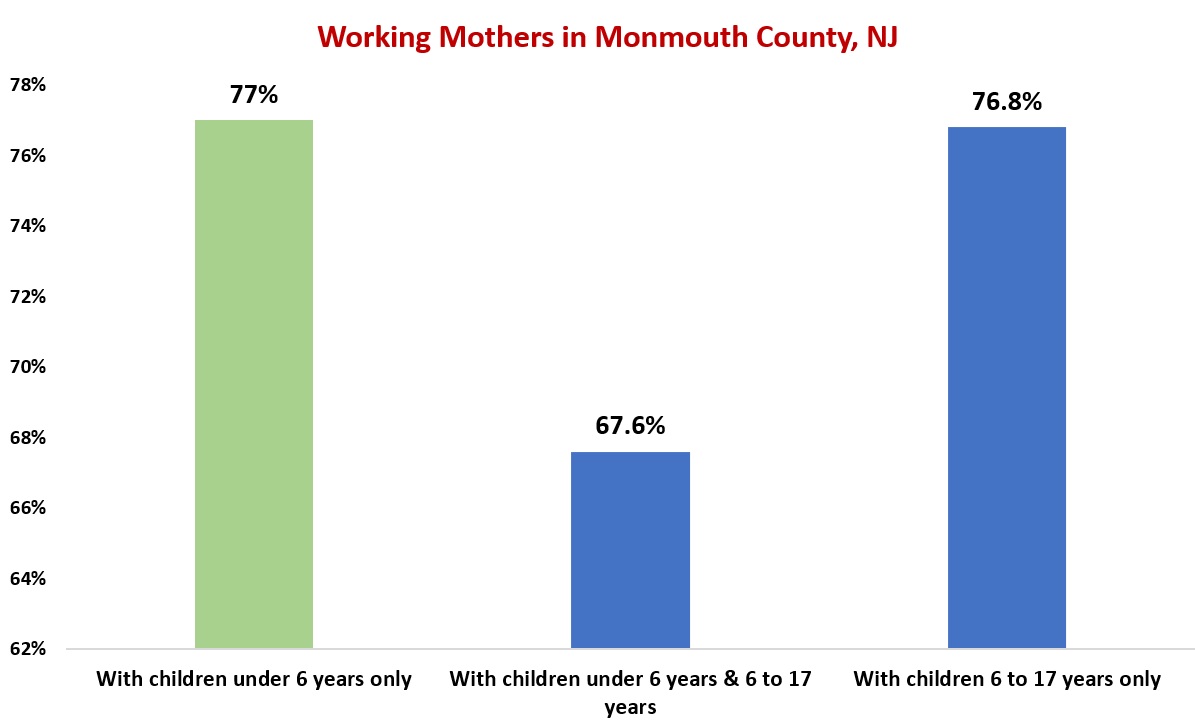Employer Child Care Toolkit
The road to economic recovery for Monmouth County begins with child care for the children of working parents. Parents depend on child care in order to obtain or retain a job.

Monmouth County Children
25,333 children from birth to age five in Monmouth County had working parents (either both parents worked or the single parent head of household worked).
45,883 children age 6-11 (school-age children) typically attended elementary school from 8:00-2:00 or 9:00-3:00, the hours of public school operation.

*Source: U.S. Census Bureau, Table S2301, Employment Status, 2021 American Community Survey 1 Year Estimates
COVID-19 Child Care Challenges
- Many parents of young children have difficulty finding programs because some have closed. Like many small businesses, child care programs have struggled to make ends meet.
- Parents of elementary school-age children will have extra challenges over the next year as schools turn to remote learning and hybrid schedules. Finding care options to fill the gap can be difficult.
- Even parents who are able to work remotely struggle without child care since it is very difficult to balance work responsibilities with caring for children at the same time. Or, supporting the remote learning of their elementary school children.
Child Care Program Safety During COVID-19
- Child care programs operate with new health and safety rules to guard against COVID-19 spread and protect the children in their care.
- Child care centers and registered family child care home programs know that children need a safe place to be and learn, and parents depend on child care to work.
Ways that Employers Can Help!
Team Up with Child Care Resources to Help Meet the Child Care Needs of Your Employees!
Child Care Resources Employer Support Menu of Services
Comprehensive or Enhanced Referral and Consultation
It can be hard to find child care. Contract with Child Care Resources to have a child care specialist conduct personalized child care searches based on employees’ needs and preferences.
On-site/Zoom Consultation
Finding child care during the COVID-19 pandemic can be an anxiety-ridden experience for employees. Contract with Child Care Resources to offer a “lunch & learn” overview about child care: the new health & safety rules, a checklist for finding quality child care before selecting care (English/Spanish), and information about child care subsidy for low-wage employees. Let CCR specialists help you help your employees!
Child Development Packets
Child Care Resources has a robust library of information on a wide range of child development and behavioral topics. In addition, CCR specialists offer parenting sessions to help reduce the stress of balancing work and family (particularly during COVID-19) and also to share strategies related to parenting challenges. Include information about child care subsidy in any onboarding material. Post these infographics (English/Spanish) in the lunch room or on a company bulletin board.
Work/Life Seminars
Child Care Resources offers lunchtime workshops (through Zoom!) designed to assist groups of employees to balance their work and family responsibilities. Polling shows that anxiety during the COVID-19 pandemic is high, particularly for families with children. Let us help you to share success strategies!



Child Care Resources
3301 C Route 66
PO Box 1234
Neptune, NJ 07754-1234
Tel: (732) 918-9901
Fax: (732) 918-9902
Email: info@ccrnj.org
Hours:
Monday-Friday: 8:30 am to 4:30 pm
*Wednesdays: 8:30 am to 6:30 pm
Child Care Tax Tips for Employers
Tax Credits for Employers Providing Child Care and/or Resource and Referral Services to Parents
Businesses can receive a tax credit equal to 25 percent of qualified expenses for employee child care plus 10 percent of qualified expenses for child care resource and referral services. The maximum total credit that can be claimed by a business cannot exceed $150,000 per taxable year. The credit is part of the general business credit and can be claimed any time within 3 years from the due date of the return. (IRS Form 8882)
To be eligible for the credit:
- The primary use of the program must be for child care and the program must meet all applicable state and local laws.
- The child care program must be open to enrollment to the employees of the business.
- Enrollment cannot discriminate in favor of highly compensated employees.
- At least 30 percent of the children enrolled in the program must be dependents of employees of the business.
Qualified child care expenses include costs paid to:
- Acquire, construct, rehabilitate or expand property that is to be used for the child care program;
- Operate the program, including the costs of training and compensation for employees of the child care program as well as scholarship programs;
- Support child care under a contract with a qualified program to provide child care to employees of the program.
Child Care Resource and Referral expenditures:
Qualified child care resource and referral expenses are amounts paid or incurred under a contract to provide child care resource and referral services to the employees of the business. Activities must be provided in a way that does not discriminate in favor of highly compensated individuals.
Employer Sponsored Dependent Care Assistance Plans For Child Care Expenses (DCAPs)
Under current federal tax law, employers can set up Dependent Care Assistance Plans, which are flexible spending accounts (Section 129 of the Internal Revenue Code). If employers choose to offer such plans, employees can set-aside up to $5,000 per year in pre-tax salary for dependent care expenses. Using pre-tax dollars means a tax savings to employees (potentially 20-40 percent of child care expenses depending upon the family’s tax bracket and expenses incurred for child care) as well as a tax savings for employers (funds set aside through a flexible spending account reduce employer payroll – for example, these funds aren’t subject to FICA or FUTA taxes). For many employees with young children, they may already be paying for child care, so the option for a flexible spending account reimburses them at a tax savings for money that would be spent anyway.
How do flexible spending plans work? An employer establishes a written plan (required by the IRS) and distributes a summary of the plan to all employees (required by the Department of Labor). Employees estimate how much they think they will spend on child care for the year. They can then choose to have up to $5,000 of their salary set aside tax-free into a flexible spending account through regular paychecks. As child care expenses are incurred, employees can submit for reimbursement from their flexible spending account (FSA). FSAs are capped at $5,000 per year. Expenses related to dependent children under age 13 or related to dependents who are mentally or physically incapable of caring for themselves (and who the employee claims as a dependent) are eligible for reimbursement through FSAs.
Here’s a calculator to help employees figure out tax savings by utilizing DCAP benefits. It’s always a good idea to consult with a tax professional, but conceptually, there are savings to be realized through the tax code for employers who wish to assist their employees with child care affordability.
Employer Resource Corner
- Employer Child Care Tax Incentives (A one page summary)
- Employee Child Care Tax Incentives (A one page summary)
